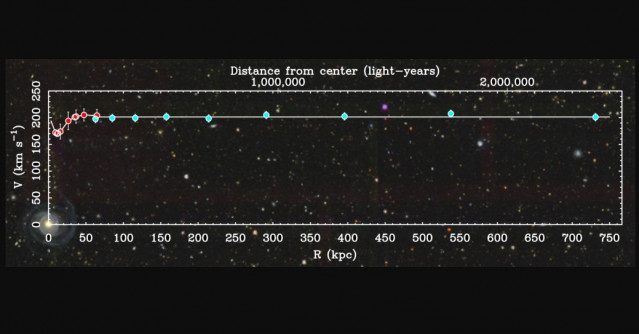Research that could reshape our perception of the universe has confirmed predictions of modified gravity as an alternative to the existence of dark matter.
Scientists at Case Western Reserve University have discovered that the rotation curves of galaxies remain flat for millions of light-years with no end in sight. It was previously thought that the rotation curves of galaxies should decrease as you look into space.
Postdoctoral researcher Tobias Mistelli has pioneered a revolutionary technique that uses “gravitational lensing” to delve into the mysterious world of dark matter.
Traditionally, the behavior of stars within galaxies has mystified astronomers. According to Newtonian gravity, stars at the outer edges should be slower due to the lower gravitational force. This was not observed, leading to the inference of dark matter. But even dark matter halos must end, so the rotation curves should not remain flat indefinitely.
MESTEL’s analysis challenges this expectation, offering a surprising revelation: the influence of what we call dark matter extends far beyond previous estimates, extending at least a million light-years from the galactic center.
Such a long-range effect would indicate that dark matter, as we understand it, may not exist at all.
“This discovery challenges current models, suggesting that dark matter halos exist on a large scale or that we need to fundamentally reevaluate our understanding of the theory of gravity,” he said.
Mistel’s findings, which are scheduled to be published in the Astrophysical Journal Letters, push traditional boundaries, said Stacy McGough, professor and chair of the Department of Astronomy in the College of Arts and Sciences.
“The implications of this discovery are profound,” McGough said in a statement. “Not only does it redefine our understanding of dark matter, it also invites us to explore alternative theories of gravity, challenging the fabric of modern astrophysics.”
The heart of Einstein’s theory
The main technique Mistel used in his research, gravitational lensing, is a phenomenon predicted by Einstein’s theory of general relativity. Basically, it happens when a massive object, such as a galaxy cluster or even a single massive star, bends the path of light coming from a distant source. This bending of light occurs because the object’s mass distorts the structure of space-time surrounding it. Light continues to be bent by galaxies on much larger scales than expected.
As part of the research, Mistel plotted the so-called Tully-Fisher relationship on a graph to highlight the experimental relationship between a galaxy’s visible mass and its rotation speed.
“We knew this relationship existed,” Mistel said. “But it wasn’t clear that the relationship would continue the further away she was. How long does this behavior last? That’s the question, because it can’t last forever.”
Mistel said their discovery underscores the need for further exploration, collaboration within the scientific community, and potential analysis of other data.
McGough highlighted the herculean, though so far unsuccessful, efforts by the international particle physics community to detect and identify dark matter particles.
“Either dark matter halos are much larger than we expected, or the whole model is wrong,” McGough said. “The theory that previously predicted this behavior is the modified MOND theory of gravity, which Motti-Milgrom postulated as an alternative to dark matter in 1983. Therefore, the obvious and inevitably controversial interpretation of this result is that dark matter “is an illusion; “The evidence for this may point to a new theory of gravity beyond what Einstein taught us.”

“Beer enthusiast. Subtly charming alcohol junkie. Wannabe internet buff. Typical pop culture lover.”

